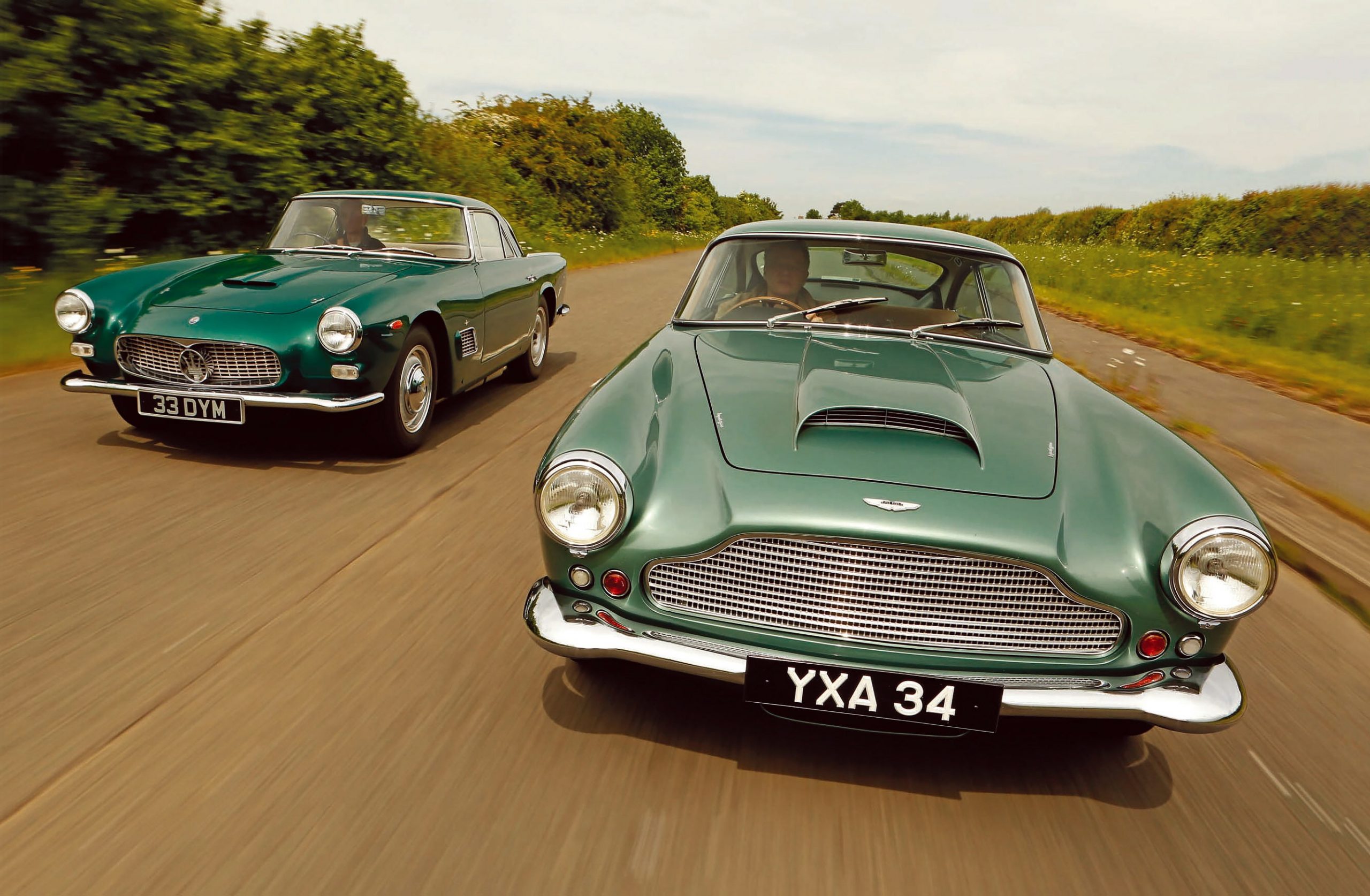
Touring’s grandest tourers Aston Martin DB4 vs. Maserati 3500. Aston DB4 takes on Maserati 3500GT in the battle of the sublime GTs. Aston Martin vs. Maserati Buckley chooses between two fabulous six-cylinder GT contenders. Milanese styling and sophisticated pace make the Aston DB4 and Maserati 3500GT natural rivals, but which does Martin Buckley prefer? Photography Tony Baker/LAT.
The lady in the burger van was not amused by us using ‘her’ layby as a turning space. She couldn’t see photographer Tony Baker skulking in the undergrowth at the exit of the corner further up the road; as far she was concerned, we were just two middle-aged hooligans in a pair of large, fruity-sounding sports cars who were frightening her customers.
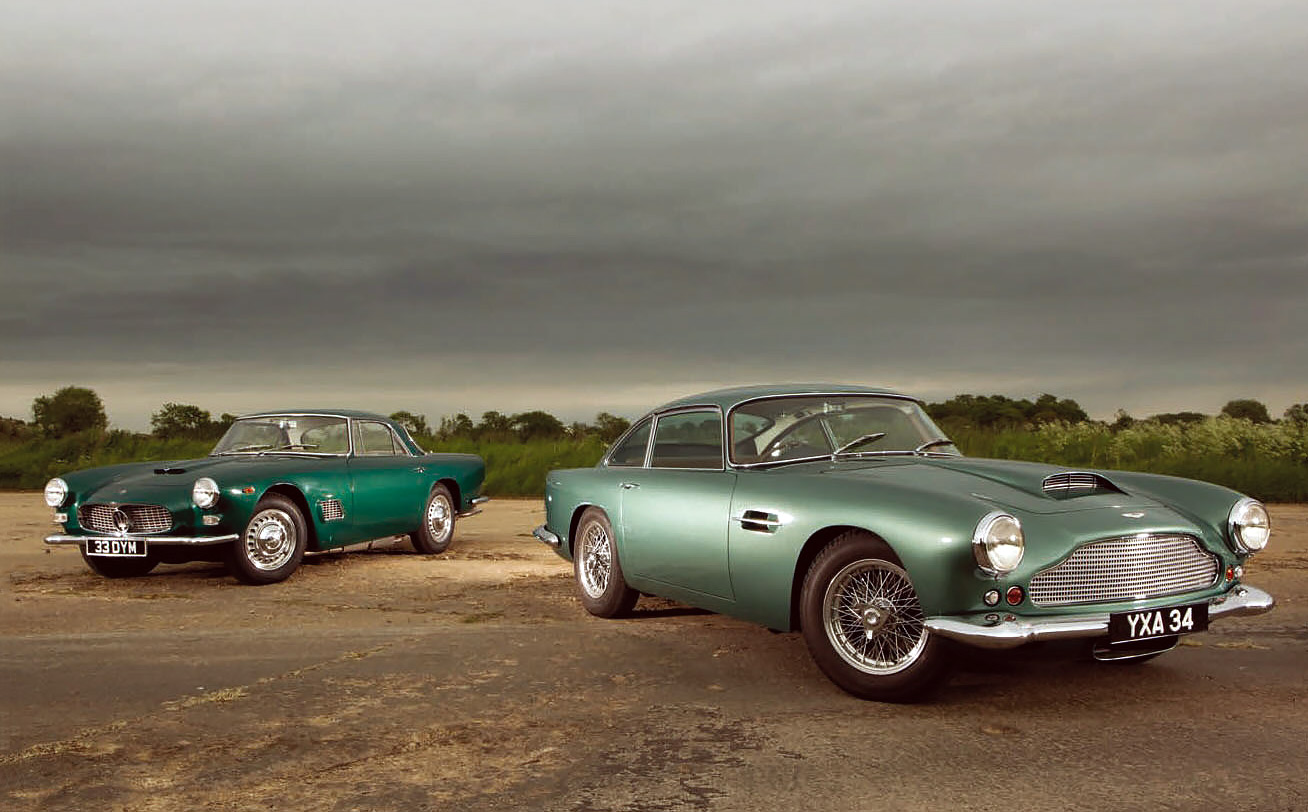
{module Aston Martin DB4 vs. Maserati 3500GT speed}
{module Aston Martin DB4 vs. Maserati 3500GT 0-60MPH}
After three or four passes, she could stand it no longer. Leaping from the van – red faced and with tattooed bingo-wings flapping aggressively – she waved me down, and bawled her displeasure through the carefully adjusted half-inch crack at the top of the DB4’s driver’s window.
Calming reassurances about my driving skills and the merit of our artistic endeavour fell upon deaf ears. Eventually, though, she retreated to her sizzling quarter-pounders, muttering something about phoning the law. You’ll be glad to hear that I didn’t let her ruin my day: with an Aston-Martin DB4 and a Maserati 3500GT to play with, it was going to take more than an irate purveyor of fast food to spoil the fun.
The charms of a twin-cam straight-six and svelte Superleggera bodywork may, of course, be lost on some people. Why should Burger Van Lady care that these two big, noisy, pollution-spewing old cars – together valued at three quarters of a million Sterling – represented just about the ultimate in true gran turismo motoring in the late 1950s and early ’60s?
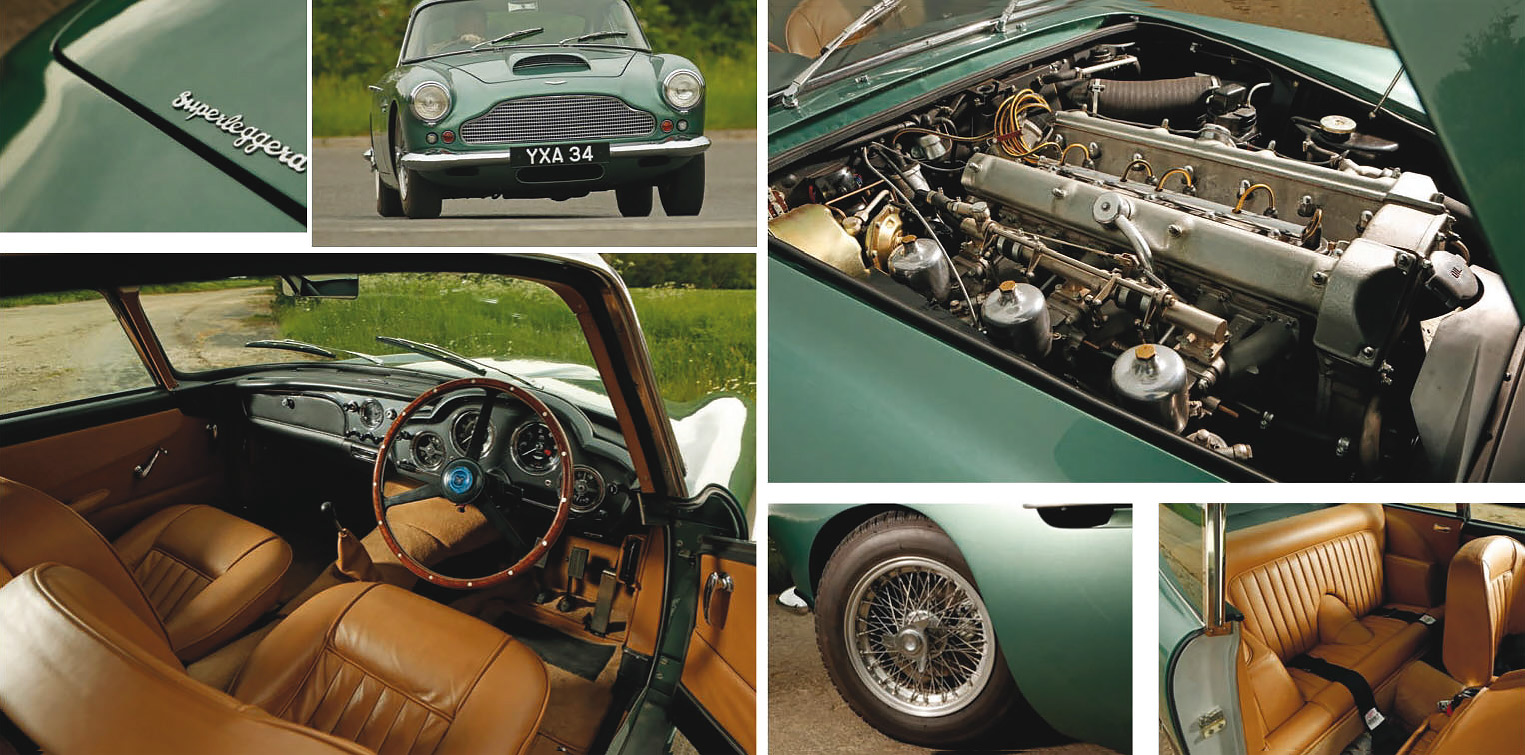
From top: Superleggera body was built under licence in Feltham and Newport Pagnell; DB4’s cabin is more sober than that of its Italian rival; this Aston’s twin-cam ‘six’ has been enlarged to 4.7 litres, meaning significant extra grunt; wires with trademark three-eared spinners; narrow rear seat.
These were machines built to take you across a country – or continent – at sustained three-figure speeds, experiencing a form a travel that was beyond most people’s imagination. They are exemplars of an era when the difference between family cars and true exotica was much greater than it is today. Both were created for a wealthy, specialised market, of course, but were also designed to be less fragile and finicky than the models that they replaced. Neither would ever exactly be commonplace, yet both were produced in surprisingly substantial numbers over several distinct series of development – no less than five in the case of the DB4, early examples of which suffered from well-publicised cooling problems.
The upshot is that they were cars that later generations could realistically dream of owning. The final manifestations of their respective bloodlines – the Mistral and DB6 – were still available new at the beginning of the 1970s. The fact that both were so crucial to the longterm survival of their respective manufacturers is another quality that makes the DB4 and 3500GT so eminently comparable. Maserati built only about 100 of its post-war 2-litre road cars, making the 3500 the Trident’s first true production model – and there has never been a more important single design in the firm’s history. Likewise, the DB4 – the first Aston Martin developed entirely by the David Brown organisation, and the first production car to be shaped by a foreign stylist – is the model that established the template and set the tone for every subsequent Aston.
In fact, I would venture that no Aston before or since has had the initial impact of the DB4. In 1958, this was the fastest four-seater (if you accepted that the rear seats were usable) that The Autocar had ever tested, famously being capable of 0-100mph and back again inside 30 seconds.
Aston Martin and Maserati came to remarkably similar conclusions in their search for the ideal specification for a mid-’50s GT. When you consider that the DB4 and 3500 were both developed by companies competing at the highest level of sports-car and Grand Prix racing, the broad technical parallels are perhaps not so surprising. Both had all-aluminium, wet-liner straight-sixes of less than 4 litres giving well in excess of 200bhp, tuned for reliable flexibility at one end and anything up to 140mph at the other.

Maserati corners in a flat, composed manner but still rides with aplomb; profile would influence that of the Lancia Flaminia GT, which was also the work of the Milanese carrozzeria.
These were engines that could trace their lineage directly to racing machinery of very recent memory. Aston Martin made no secret of the fact that the DB4’s seven-bearing, 3.7-litre ‘six’, designed by Tadek Merek, had been developed in the DBR sports cars. Similarly, Giulio Alfieri’s 3485cc unit, with its 12-plug head and shim-adjusted bucket tappets, was a product of both the 350S and the 250F racers.
Weighing in at c3000lb apiece, both cars featured high-fashion styling by Touring of Milan, beautifully crafted in aluminium. The Maserati’s body was produced in Touring’s own factory (alongside various models from Alfa and Lancia), whereas Aston took a licence on the famous Superleggera method of construction and built its shells in-house, first at Feltham and later (from 1963) at Newport Pagnell.
Under the skin, both cars had ruggedly conventional but well-groomed chassis. Here were prime examples of what could be done with a well-located live axle and careful weight distribution by engineers who were still mistrustful of fully independent rear ends on fast cars. Aston’s Harold Beach would have liked a de Dion set-up for his DB4 but, for want of a sufficiently quiet differential, made do with a Watt linkage and trailing links for the axle. He coil-sprung the Aston, whereas Alfieri thought that semi-elliptics were adequate for the new Maserati GT; the Ghibli and Indy used the same basic set-up into the ’70s, so maybe he was right.
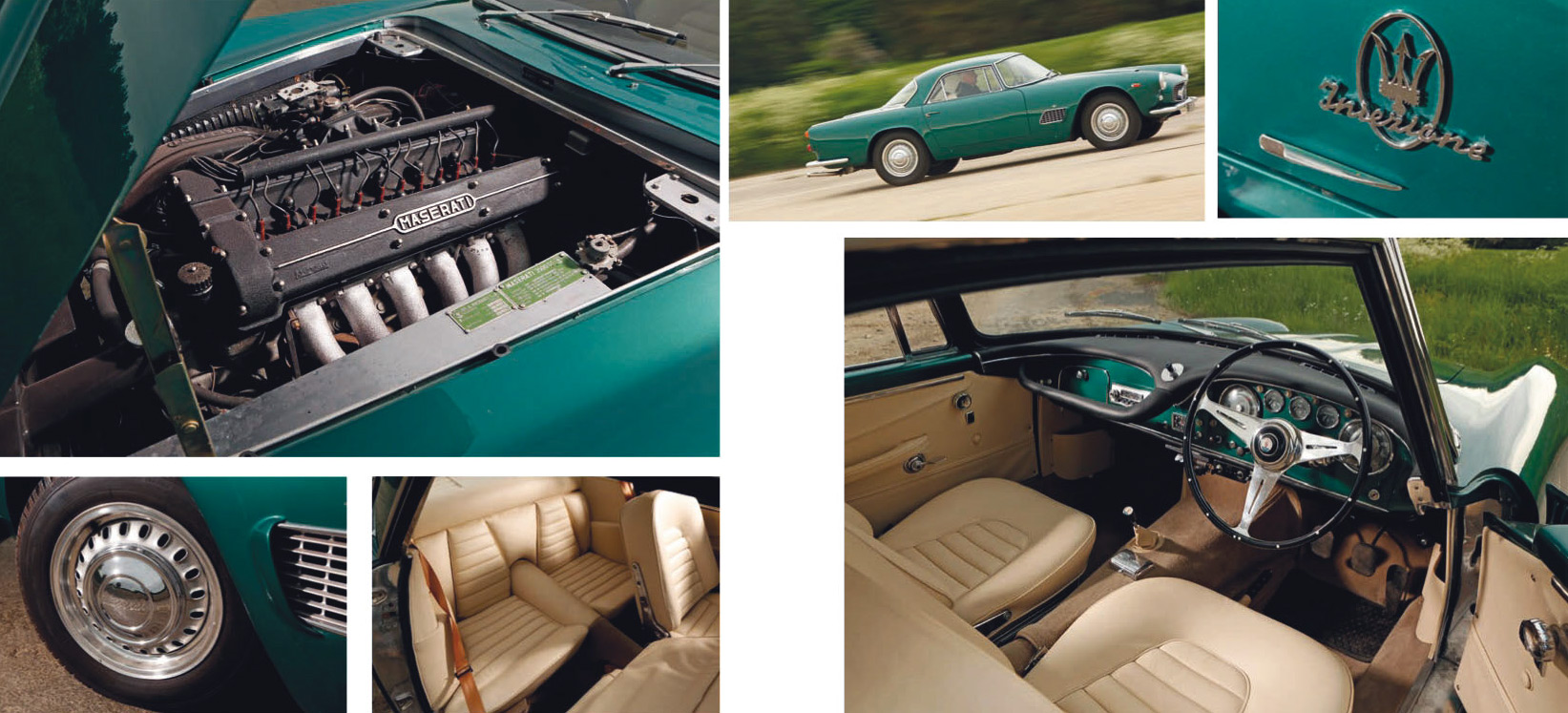
From top: Italian script but the Lucas injection system is British; vast thin-rimmed wheel and grab-handle dominate fascia; Maserati 3500GT’s ‘six’ features a twin-plug head design; pressed-steel wheels and hubcaps may sound prosaic but they look great; beautifully trimmed rear seats.
A master in the art of aluminium casting, Maserati engineered the 3500 around an international mix of bought-in components (a Salisbury rear axle, ZF gearbox, plus Alford and Adler wishbone front suspension to name just a few). Aston took a more bespoke approach, with its own top and bottom ball-jointed front end – again developed on the Le Mans cars – rack-and-pinion steering, plus four-speed ’box supplied, of course, by patron David Brown.
‘Our’ Maserati is a late example with Lucas fuel injection, four-wheel Dunlop discs and a five-speed ZF gearbox. In fact, 33 DYM is an ex-Earls Court Motor Show and press car that was tested by Gregor Grant in Autosport. It is therefore one of the last of nearly 2000 to feature this body style, which was first seen in 1957 and remained current through to 1965. At just over £3500, a Series 2 Aston Martin DB4 such as this one (with its improved brakes and bigger capacity, 17-gallon sump) was more than £2000 cheaper than the import-duty-loaded Italian.
Out on the road, these are cars that make you feel special. They are imbued with a power and poise that lifts you above humdrum concerns, although their heavy controls and lusty feel won’t be to all tastes. Both require the sort of physical effort that places their origins firmly in the ’50s.
Once inside, each provides a noble view down a long shapely bonnet but, of the two, the Aston Martin has the better-planned, better-ventilated interior. It has slim roof pillars and a good driving position where your hand falls naturally from the big 16in steering wheel to the gearlever, and where your feet work easily on the nicely spaced floor-hinged pedals. The delicate rear-view mirror makes following vehicles look lower and meaner than they really are, and everything about the cabin is neatly trimmed for an aura of workmanlike luxury.
The Maserati’s interior is smaller, but less sober and well ordered. It’s flashier, perhaps, with its electric windows and fat, cream leather seats that are needlessly large and not very embracing – although potentially nervous passengers get an almost comically massive padded grab-handle as compensation. You sit commandingly in the 3500, with your arms stretched out on the big black plastic-rimmed wheel. Your knees do feel somewhat high but your right foot moves effortlessly from brake to accelerator, so heel and toeing is very natural.

From top: floor-hinged pedals in the English car; trident logo on elegant gearstick; whether you prefer the notchback styling of the Maserati or the fastback Aston, both are the very definition of a sophisticated grand tourer.
Even today, either car will shoot you up to 100mph before you have grabbed fourth gear. It is not quite a fair fight, though, because ‘our’ pampered DB4 – restored in 2012 by Thornley Kelham – has a variety of RS Williams improvements.
Chief among the mods is a 4.7-litre engine conversion that gives it the best part of an extra 100bhp, plus goodness knows how much additional torque. The rev-counter needle certainly leaps crisply round the dial at the merest caress of the throttle pedal, and the only thing missing from a perfect set of gear ratios is a nice high overdrive that would cut down the noise. This car feels as if it will sit on an unrestricted highway at 130mph (with lots more to come, if you feel the need), getting there in a potent but beautifully modulated flow of power that is raw and brawny but never brutal or vicious.
With the revs rising, the Aston and Maserati sound similarly expensive, their fussy, well-bred sophistication combined with throatily booming exhaust notes. Should you not wish to draw attention to yourself, however, either car will pull away with the decorum of a mayoral limousine at low speeds, with clutches that just about match each other for substantial heft combined with easy-to-use, snatch-free smoothness.
In the DB4, most open-road overtaking manoeuvres can be dispatched without changing out of top – just as well, because the gearbox has a gritty, macho feel about it that matches the car’s personality. In the Maserati, you need to access the mid-range revs or just accept that you can’t whip past traffic with the same aggression. The 3500’s five-speed ZF gearbox is naturally more versatile and lighter to handle, but with a rather narrow gate – it’s easy to slot it into fifth when you’re looking for third. There’s also quite a lot of gear whine once the oil has warmed.
Like the Aston, the Maserati has a magnificently flexible motor, pulling in one long, even lunge from the steady 500rpm tickover to a throaty 5500rpm, where it makes the most of its 235 horses. You could order any of seven different final-drive ratios for your thirty-five hundred, tailoring it for maximum acceleration, optimum top speed, or a good compromise between the two. I’m not sure which back end this car is running, but it feels strong and healthy, illustrating how well these Lucas injection engines can pull when they are properly set up. Anybody would be content with it and – allowing for the British car’s sneaky extra litre – it’s easy to see how the two would have been closely matched in straight-line urge. According to period road tests, the Aston probably enjoyed a slight edge.
Both cars have a flat, firm but comfortable ride, reassuringly potent servo-assisted disc brakes and thoroughly vice-free handling. Again, there’s the caveat that, with its upgraded dampers and revised geometry, the Aston is probably sharper than it would have been in 1961. It just feels ‘sorted’ in a way that leaves the Maserati seeming ever so slightly ponderous – mainly because the Italian’s steering is lower geared and, being a box rather than a rack, is inherently less direct. It corners flat and true, and holds no surprises for novice or hooligan. Somehow, though, it feels more of a period piece. It is as if its designers realised that the typical playboy/industrialist owner would be more focused on smoking a cigarette while stroking his girlfriend’s thigh, so why make things more difficult?
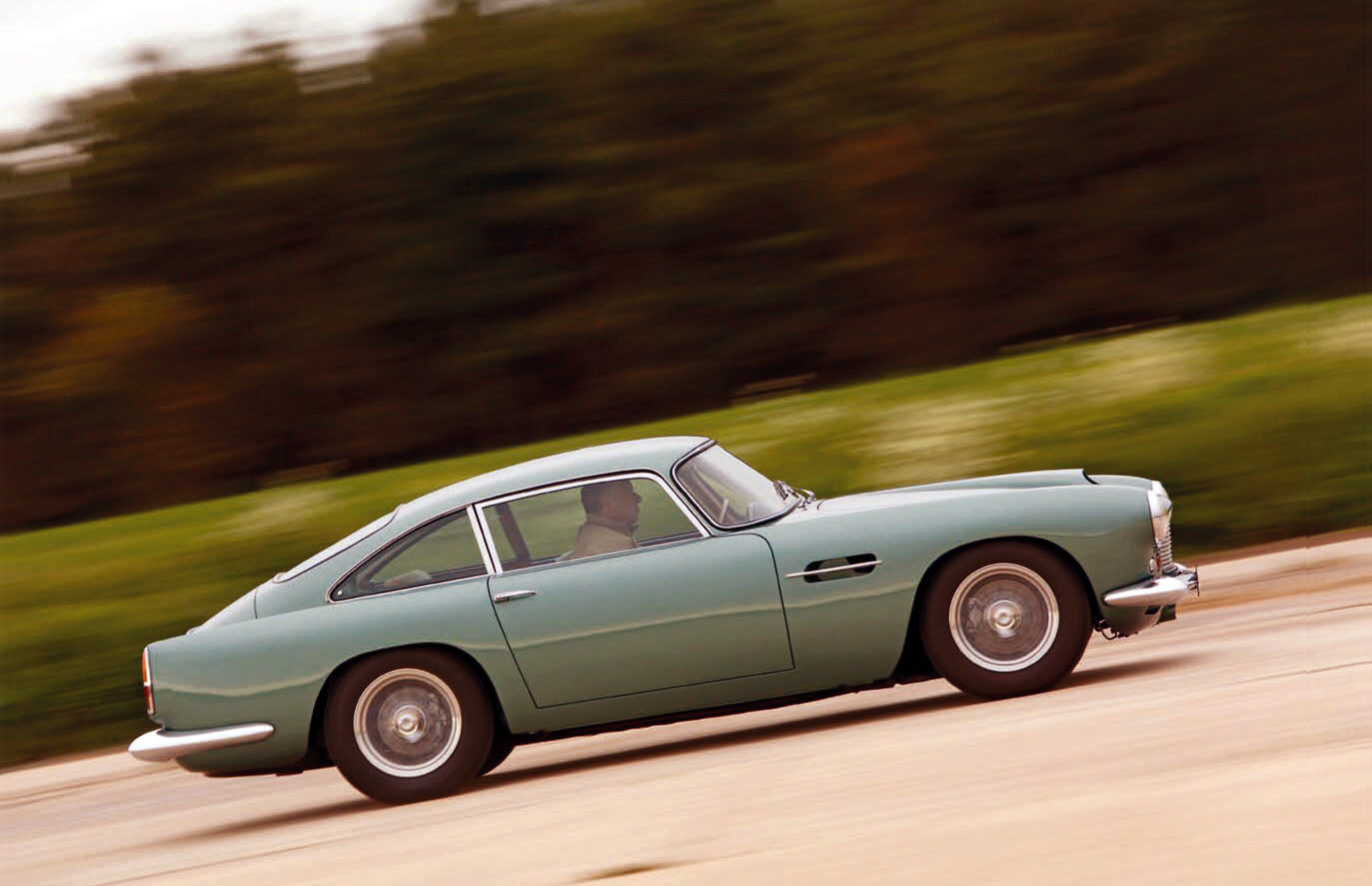
From main: the DB4’s flowing profile is more familiar than that of the Maserati and influences Aston design even today; frontal styling would gain faired-in headlights for the later DB5 and DB6.
That’s not to say that this DB4 is so far from standard: I’ve driven enough of them to know that. Shod, as it is, with period-correct ‘full profile’ tyres, the essential characteristics can’t be too far removed from the original designer’s intent. Its direct, slop-free steering loads up for safety on tight bends taken quickly, the idea being that you unload it by booting the tail round with the throttle. It is hard to resist the urge to adopt tearaway tactics on roundabouts, where you can control a slide with surprising delicacy.
Thank goodness the lady in the burger van didn’t see me contemplating that! Of course, if you and I were standing in a layby one sunny afternoon we might relish the idea of watching an Aston DB4 and a Maserati 3500GT being gunned up a country road – some people would even pay for the privilege – but wouldn’t it be a boring world if we all liked the same things?
As to which one you take home, I suspect that the decision – then and now – would come down to the two basic things that make the world go round: looks and money. If you feel jaded by the continual hype that surrounds the Aston marque – and the ’60s models in particular – you will feel naturally disposed to finding the Maserati prettier, or a least less familiar. Today, thanks to the mystical ‘Aston tax’ (and the exploits of a certain fictional secret agent), this DB4 could command well over double the £200,000 that it would take to part the fully restored Maserati from its current owner. Such a price differential is obviously nonsense, but it must make the 3500GT some sort of bargain.
Thanks to Hal Walter; Thornley Kelham: www. thornleykelham.com; Cotswold Classic Car Restorations, where the Maserati is currently for sale: www.cotswoldclassiccarrestorations.co.uk
“BOTH SOUND SIMILARLY EXPENSIVE, WITH A FUSSY SOPHISTICATION AND THROATY EXHAUST”
ASTON MARTIN DB4
Sold/number built 1958-1963/1185
Construction steel chassis with aluminium Superleggera body
Engine all-alloy, dohc 3670cc straight-six, twin or triple SU carburettors
Max power 240bhp @ 5500rpm
Max torque 240lb ft @ 4250rpm
Transmission four-speed DB manual, driving rear wheels
Suspension: front coil springs, double wishbones, telescopic dampers, anti-roll bar rear live axle, coil springs, trailing links, Watt linkage, lever-arm dampers
Steering rack and pinion
Brakes discs all round, with servo
Length 14ft 9in (4496mm)
Width 5ft 6in (1676mm)
Height 4ft 4 ½ in (1334mm)
Wheelbase 8ft 2in (2489mm)
Weight 3080lb (1400kg)
0-60mph 9.3 secs
Top speed 140mph
Mpg 16
Price new £3505 Now £400,000
MASERATI 3500GT
Sold/number built 1957-1964/1981
Construction steel chassis with aluminium Superleggera body
Engine all-alloy, dohc 3485cc straight-six, twin spark-plugs per cylinder, triple Weber carburettors or Lucas injection
Max power 235bhp @ 5800rpm
Max torque 232lb ft @ 4800rpm
Transmission five-speed ZF manual, driving rear wheels
Suspension: front coil springs, double wishbones rear live axle, semi-elliptics, anti-roll bar; telescopic dampers f/r
Steering recirculating ball
Brakes discs all round
Length 15ft 8 ¼ in (4780mm)
Width 5ft 9 ¼ in (1760mm)
Height 4ft 3 ½ in (1310mm)
Wheelbase 8ft 6 ½ in (2600mm)
Weight 3175lb (1440kg)
0-60mph 7.5 secs
Top speed 129mph
Mpg 16
Price new £5852 Now £200,000
‘THE AUTOCAR FOUND THAT IT WAS CAPABLE OF 0-100MPH AND BACK AGAIN INSIDE 30 SECS’
Touring of Milan
Founded in 1926, the Milanese carrozzeria patented its famous Superleggera method of construction in the late ’30s. Its origins can be traced back to the firm’s activities producing air frames and Weymann fabric bodies. By cladding a skeleton of narrow-gauge steel tubes in unstressed aluminium panels, the designers were able to retain the lightness of the Weymann body but with greatly increased strength. The technique also meant that the skin could be formed in voluptuous streamlined shapes, most memorably on the Alfa 8C chassis.
Touring’s association with Aston Martin began with a DB2/4-based roadster that was shown at Turin in 1956, and which had been commissioned as a competition prize by the Daily Express. Aston’s John Wyer favoured Superleggera construction, and it seemed natural for the firm to go for Italian styling for its next generation of cars – particularly since in-house designer Frank Feeley was unwilling to move from Feltham to Newport Pagnell.
Aston’s chief engineer Harold Beach – who thought the people at Touring were “a fantastic crowd” – designed a platform chassis to which the Italians could weld their tubular frame, and the first DB4 prototype, styled by Federico Formenti, was running by March 1957.
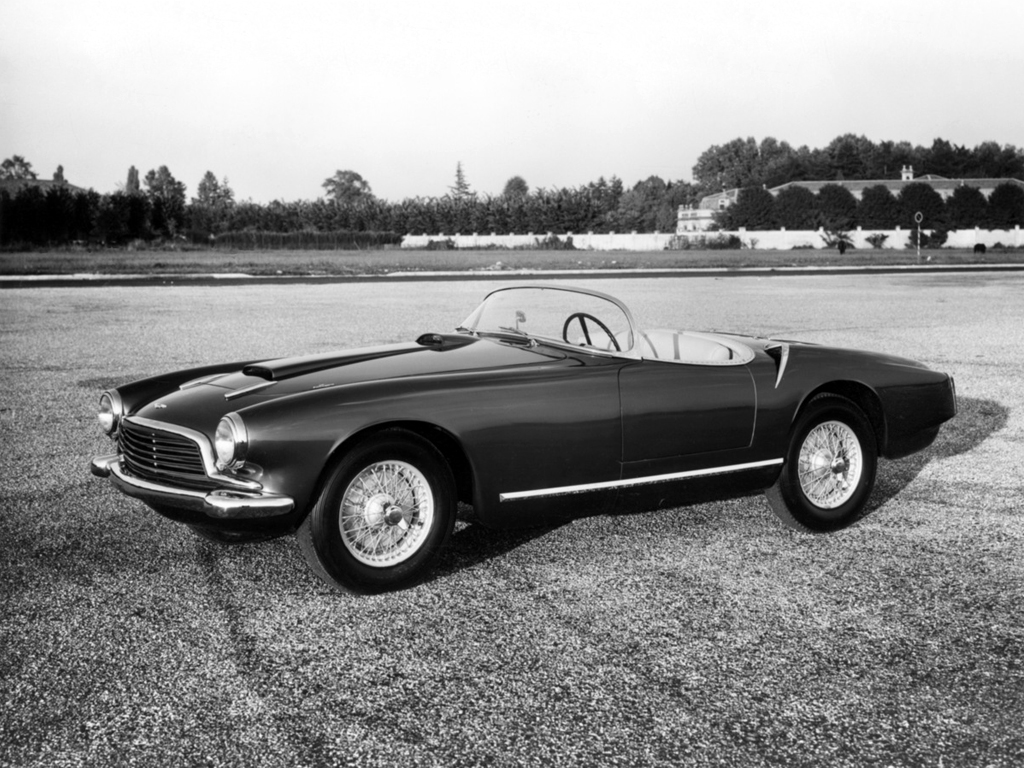
DB2/4 roadster was the first Aston bodied by Touring.
The same month, Maserati showed the Touring-styled 3500GT at Geneva, its handsome lines having beaten rival Zagato and Allemano designs. As well as being the Trident’s first production car, the 3500GT opened a whole new chapter for Touring, which by then was building series models for Alfa and was about to start making Lancia Flaminia GTs. Production would increase from fewer than 300 bodies a year to a peak of nearly 3000 in 1960. The firm would become truly industrialised; instead of hand beaten panels, bodies would be built from large sections pressed by outside suppliers and assembled at a modern facility in Nova Milanese.
The delays caused by the ambitious move to this new factory, compounded by strikes and difficulties with newly hired workers, eventually caught up with the firm. It was undercapitalised, too; the directors had financed the plant with their own funds, leaving nothing to fall back on when the economy faltered. The cancellation of a contract with Rootes to build the Alpine and the Super Minx probably sealed Touring’s fate. It went into receivership in 1963, although production continued until 1965.
Among the last one-offs was the Aston DBS prototype, shown at Earls Court in 1966. Other than the Shah of Iran’s 5000GT though, and several unsuccessful attempts to update the 3500GT, Touring never bodied another Maserati.
{CONTENTPOLL [“id”: 68]}





